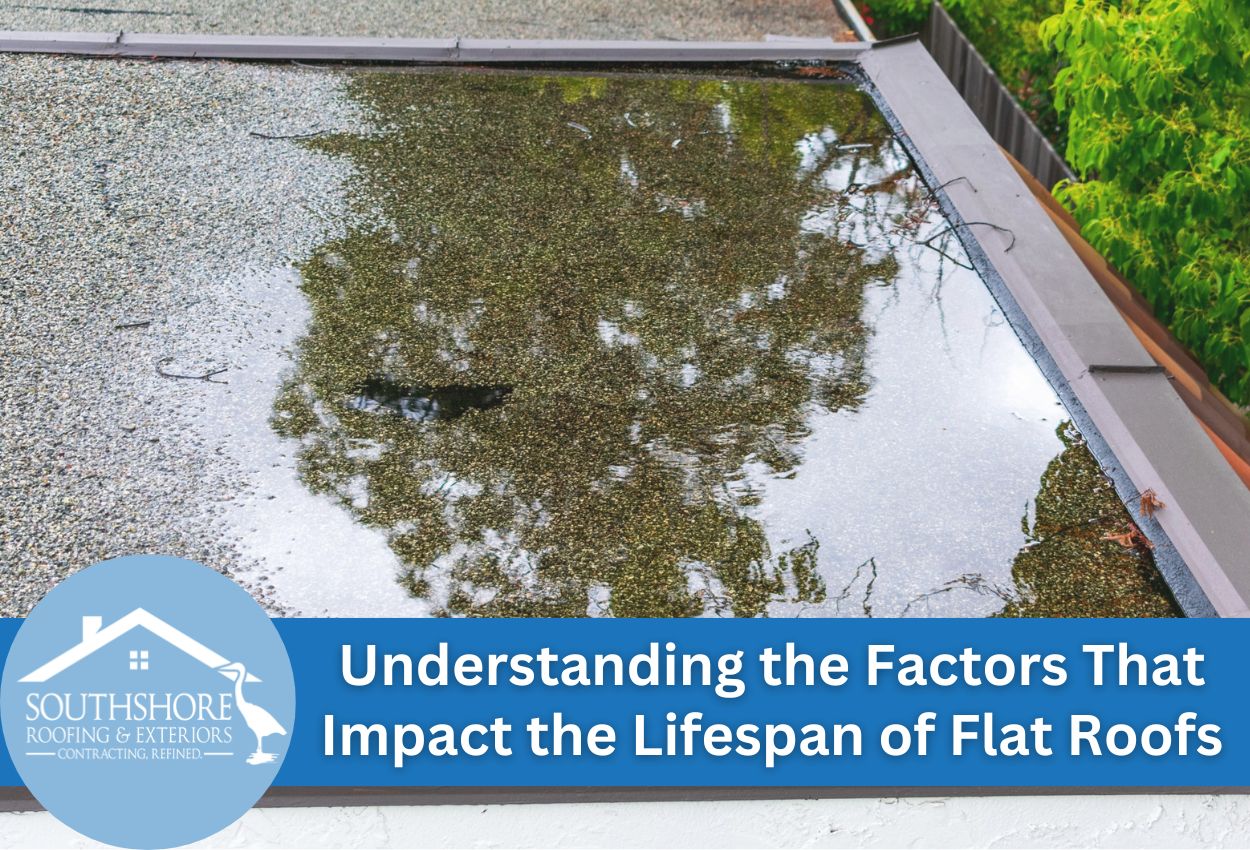Flat roofs are a common feature on many Tampa buildings, both commercial and residential, but their repairs don’t always last as long as property owners hope. While a properly executed flat roof repair can extend your roof’s service life significantly, several critical factors determine whether that repair will last five months or five years. For Tampa property owners dealing with Florida’s intense sun, frequent storms, and occasional hurricane threats, understanding these factors becomes even more crucial.
The lifespan of flat roof repairs varies dramatically based on both environmental conditions and human decisions. From the quality of materials used to the expertise of the installation team, each element plays a vital role in determining how long your roof repair will effectively protect your property.
Knowing what impacts the sustainability of repairs helps property owners make informed decisions that maximize their investment. Whether you’re considering preventative maintenance or facing an immediate repair need, recognizing these influencing factors can save significant time and resources.
Weather and Environmental Effects on Repairs
Tampa’s unique climate creates significant challenges for flat roof repairs. Florida’s intense UV rays are particularly damaging, with sunlight breaking down roofing materials at an accelerated rate compared to northern regions. The high levels of ultraviolet rays cause flat roofing membranes to become brittle and crack prematurely, even when high-quality materials are used.
Humidity levels in Tampa routinely exceed 70%, creating perfect conditions for moisture-related problems. This constant moisture exposure weakens adhesives and sealants while promoting organic growth that can compromise repairs. When summer afternoon thunderstorms arrive, they often leave standing water on flat roofs, which adds weight and creates potential entry points for leaks around repair areas.
Temperature fluctuations, though less extreme than in other parts of the country, still cause repeated expansion and contraction that test the integrity of membrane seams that were recently repaired. During hurricane season, high winds can lift edges of newly repaired sections if they haven’t fully bonded, while wind-driven rain finds vulnerabilities in even minor installation flaws.
Organic debris from vegetation surrounding the roof can build up on flat roofing surfaces, trapping moisture and providing nutrients for moss and algae growth. Debris like tree branches and twigs can penetrate repair areas and create pathways for leaks.
Material Selection: The Foundation of Lasting Repairs
Selecting the right materials for flat roof repairs is a leading factor that determines how long repairs will last. Different roofing membranes perform distinctly under Florida’s intense sun and frequent storms. Modified bitumen offers excellent waterproofing and durability, but can soften in extreme heat if not properly formulated with UV-resistant compounds. EPDM (rubber) membranes provide exceptional flexibility and weather resistance, making them suitable for Tampa’s temperature fluctuations, though they may require additional UV protection in our sun-drenched environment.
TPO and PVC membranes have gained popularity among Tampa roofing professionals for their reflective properties that reduce heat absorption. TPO offers good resistance to mold and dirt accumulation but may not withstand ponding water as effectively as PVC, which provides superior chemical resistance and durability against standing water common after heavy Florida downpours.
Material compatibility with the existing roofing system directly impacts repair success as well. Adhesive failure often occurs when new materials expand and contract at different rates than the original roofing material. Professional roofers carefully assess existing systems before selecting repair materials, ensuring they’re compatible in terms of chemical composition, flexibility, and thermal movement. This careful matching process, particularly important in Tampa’s high-temperature environment, creates seamless integration that withstands weather extremes and extends the overall lifespan of the roof.
How Installation Quality and Workmanship Standards Affect Repairs
Even the highest quality materials will fail prematurely if they’re installed incorrectly. Professional workmanship is perhaps the most significant factor determining how long a flat roof repair will last in Tampa’s challenging climate. Proper sealing techniques create watertight barriers that prevent moisture intrusion during Florida’s intense rainstorms. Experienced roofers understand the critical importance of clean, smooth application of sealants and adhesives, ensuring full bonding without air pockets or weak spots that could become failure points.
Flashing details around roof penetrations, edges, and transitions require careful attention. These vulnerable areas account for approximately 80% of flat roof leaks in Tampa properties. Professional contractors install appropriate counterflashing, pitch pockets, and edge treatments that direct water away from seams rather than toward them. The proper overlap of materials, especially at seams, creates a barrier to water that maintains integrity even as materials age under Florida’s harsh UV exposure.
Common installation errors include inadequate surface preparation, which leads to adhesion failures, and improper drainage solutions, which allow water to pool, accelerating material breakdown. Rushed application during Tampa’s unpredictable weather patterns often results in moisture trapped within the roof system, causing blistering and delamination. Professional Tampa roofing contractors follow manufacturer specifications precisely, allowing proper curing time between application steps to ensure maximum adhesion and material performance.
The Impact of Building Usage and Roof Traffic
How a building is used plays a significant role in determining how long flat roof repairs will last. Commercial buildings in Tampa typically experience different stress patterns than residential structures, with commercial roofs often housing HVAC systems, satellite equipment, and other mechanical units that create vibration and require regular maintenance visits. These factors introduce consistent points of stress around repaired areas that can even damage professionally installed repairs over time.
Foot traffic represents one of the most damaging forces affecting flat roof repairs. Maintenance workers accessing rooftop equipment often follow the same paths, creating wear patterns that accelerate material breakdown. Industrial buildings typically face the highest traffic demands, with some roofs serving as platforms for equipment maintenance or even material storage. Each footstep compresses insulation, potentially creating low spots where water collects after Tampa’s frequent rainstorms.
Protecting your flat roof requires strategic planning of rooftop access. Installing designated walkway pads creates safe pathways that absorb impact while protecting the underlying membrane. Organizing rooftop equipment in centralized locations minimizes the need for widespread access across the roof surface. For buildings with high maintenance requirements, installing permanent walkway systems with load-spreading features preserves repair integrity by distributing weight across wider areas rather than creating focused pressure points.
Maintenance Routines That Extend The Lifespan of Repairs
Putting regular maintenance routines in place extends the lifespan of flat roof repairs for Tampa properties. A well-structured seasonal maintenance program should include quarterly inspections specifically tailored to address the effect of weather on the roofing system. For instance, spring inspections should focus on cleaning drainage systems before summer storms while fall maintenance needs to prepare the roof for potential hurricane conditions by securing loose components and checking sealant integrity.
Proper drain maintenance is particularly critical in Tampa’s climate. Regularly cleaning gutters, scuppers, and internal drains prevents this common issue. Monitoring for early warning signs between professional inspections also helps property owners address minor problems before they impact existing repairs. Warning signs include small blisters in the membrane, bubbling or separation at seams, and minor leaks that appear during heavy rain.
Preventative treatments like reflective coatings applied every 2 to 5 years provide additional protection against Tampa’s intense UV exposure while extending repair durability. These coatings reduce thermal cycling and prevent the roofing materials from aging early.
Choosing Between Repair and Replacement: The Long-Term Perspective
At some point, every Tampa property owner faces the critical decision between continuing with repairs or investing in a complete roof replacement. The amount of repairs needed often signals underlying issues that may not be visible on the surface. When your flat roof requires multiple repairs in the same area, it typically indicates deterioration of the roofing material or insulation beneath the membrane. These hidden problems mean that new repairs are being applied to an increasingly unstable foundation, dramatically reducing their effective lifespan.
The 30% rule provides a practical framework for decision-making: when repairs would cover more than 30% of the total roof area, replacement generally offers better long-term value. Similarly, if repair costs would exceed 30% of replacement costs, a full replacement often makes more financial sense. For Tampa buildings, where summer heat stress and storm exposure accelerate deterioration, this threshold may be even lower.
A strategic approach involves developing a phased plan that maximizes your investment. For roofs approaching the end of their serviceable life but not yet failing critically, targeted high-quality repairs can extend functionality for 2 to 3 years while you budget for replacement. Tampa roofing professionals can help evaluate your specific situation, considering factors like building use, current roof condition, and financial constraints to develop the most cost-effective long-term strategy that balances immediate needs with future planning.
Ensure Your Flat Roof Lasts with SouthShore Roofing & Exteriors
From selecting the right materials to professional installation, every detail counts towards extending the lifespan of your repairs. At SouthShore Roofing & Exteriors, we emphasize the importance of quality materials and expert craftsmanship.
Don’t let the harsh Florida weather shorten the life of your flat roof. Call us today at (813) 400-3329 to schedule a consultation and ensure your roof is in top condition with services tailored to combat Tampa’s unique environmental challenges. Trust us to provide durable solutions that protect your investment.







